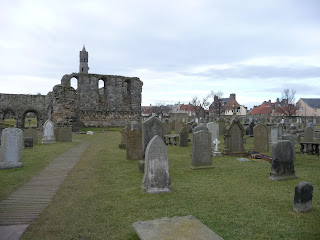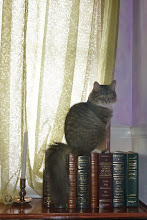 Emily and I in front of West Port gate, one of the few surviving Scottish city gates. It was erected in 1589!
Emily and I in front of West Port gate, one of the few surviving Scottish city gates. It was erected in 1589! We stopped for ice cream. I had banoffee flavored ice cream, a delicious combination of banana and toffee that is a common dessert flavor in the UK.
We stopped for ice cream. I had banoffee flavored ice cream, a delicious combination of banana and toffee that is a common dessert flavor in the UK. St. Andrews Cathedral, or what is left of it. The large round patches of stone are where the pillars stood in the nave.
St. Andrews Cathedral, or what is left of it. The large round patches of stone are where the pillars stood in the nave. The graveyard of St. Andrews cathedral, as shot from the "inside" of the church.
The graveyard of St. Andrews cathedral, as shot from the "inside" of the church. Parts of St. Andrews castle. The Scots were pretty hard on their architecture!
Parts of St. Andrews castle. The Scots were pretty hard on their architecture! The North Sea, as seen from the base of the castle.
The North Sea, as seen from the base of the castle.
Emily caught unawares, looking quite like...

Keira Knightly, a la Pride and Prejudice.

The spot where Patrick Hamilton was executed in 1528. Patrick Hamilton was a student at St. Andrews University. He became a Protestant Reformer and was the first martyr in the Scottish Reformation to be burned at the stake heresy. It's believed that you won't graduate if you step on the initials. Therefore you see a lot of students shortly after graduation hopping and dancing on top of the stones.

No one knows how this face appeared in the wall above the PH. Legend has it that when Patrick Hamilton died, his soul flew up toward heaven but collided with the wall and never made it up there.
 A Pictish cemetery on Hallow Hill, c. 5th-9th century CE.
A Pictish cemetery on Hallow Hill, c. 5th-9th century CE. A beautiful view of the North Sea from a coastline trail somewhere between St. Andrews and Pittenweem.
A beautiful view of the North Sea from a coastline trail somewhere between St. Andrews and Pittenweem. This is the quaint fishing town of Anstruther, home to the Anstruther Fish Bar, a delectable "wee chippy" that won the Seafish "Best Fish and Chips in the UK" award, according to the Times. I believe it--they were delicious!
This is the quaint fishing town of Anstruther, home to the Anstruther Fish Bar, a delectable "wee chippy" that won the Seafish "Best Fish and Chips in the UK" award, according to the Times. I believe it--they were delicious! Juliana in front of the coolest wall in town. It's a mosaic made entirely out of seashells. A few have fallen off, as you can see, but it's still fun to look at. Also interesting to note: about three out of every four houses that I saw in Scotland had their own names. People etch them into the glass or mantle above their doorway. This one doesn't have a name on display, but it's so unique that you can bet it has its own local moniker.
Juliana in front of the coolest wall in town. It's a mosaic made entirely out of seashells. A few have fallen off, as you can see, but it's still fun to look at. Also interesting to note: about three out of every four houses that I saw in Scotland had their own names. People etch them into the glass or mantle above their doorway. This one doesn't have a name on display, but it's so unique that you can bet it has its own local moniker.
This is the entrance to St. Fillan's cave. St. Fillan was an 8th-century hermit (and son of Irish royalty) who whiled away his years in this cave by writing sermons by the light of his luminous left arm. He's now the patron saint of the mentally ill. Go figure.
 Me admiring the inside of the cave. So roomy and cozy!
Me admiring the inside of the cave. So roomy and cozy!
The deep recesses of the cave. No, that's not a patch of Godlight, that's a bulb put in by the owners. Good thing St. Fillan had a handy-dandy glowing arm. It's dark in there!

No comments:
Post a Comment